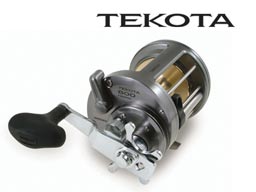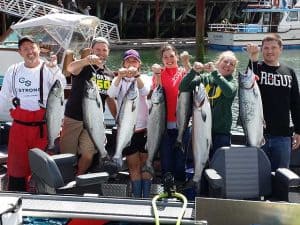Check out our Astoria Fishing Charters and Washington Halibut Charters
 The Shimano Tekota reel has been on the market for around a decade now and is one of the favorite reels of big water fishermen here in the NW. Even though this reel comes in a non line counter version you rarely see them in use, it’s the line counter Tekota that everyone utilizes.
The Shimano Tekota reel has been on the market for around a decade now and is one of the favorite reels of big water fishermen here in the NW. Even though this reel comes in a non line counter version you rarely see them in use, it’s the line counter Tekota that everyone utilizes.
I’ve used the Shimano Tekota 500 LC reel on my guide boat during every trip going on 9 years now and I’m going to share my experience and take on the good and bad regarding its construction and performance. This is a robust reel with a lot of quality and great features but it does have some flaws and downside. We’re going to take a look at some of the advantages and disadvantages of the Shimano Tekota 500 LC.
The Shimano Tekota’s Line Counter
This reel has the best integrated line counter on the market. Oftentimes you will see a line counter reel that looks like the manufacturer added the line counter as after thought. This isn’t the case with the Tekota LC, the line counter is cleanly integrated into the reel and the counter’s rounded corners make it comfortable to hold.
The line counter itself is durable and with minimal maintenance, will outlast the other components on the reel during heavy use. I’ve never had the line counter mechanism fail. The only problems I’ve had with the actual line counter are fogging of the display window due to internal moisture. On another occasion the plastic see through window covering the line distance numbers came off.
These reels hold approximately 225 yards of 65# braided line.
One downside that isn’t obvious even after using the reels for a while is that the reel needs to be completely loaded with line in order for the line counter to be accurate. So when you break off 20 to 50 yards of line, please realize that there is going to be a difference in the amount of line that this reel says is deployed verses the other reels in your spread. This can be a huge problem when targeting suspended fish or when fishing multiple rods down the same side of the boat. A little bit of lost line isn’t enough to make much of a difference but if your reel has noticeably less line on it make sure you compare how much it is off so you can still keep it fishing at the same level as the others.
The “less than full” line counter problem that is inherent in this reel is also a major reason to not use the larger Tekota 600 LC unless you really plan on doing some deep drop fishing and don’t mind having to respool an extra 100+ yards onto the reel to keep its line counter accurate. The 600 LC’s high line capacity is nice but if you don’t really need that much line, you will find it prohibitively expensive to keep filling such a large reel all the way to the top with braid every time the reel gets a little less than full.
The Handle
An obvious advantage that the Tekota has over traditional level wind reels, is its large oversize handle. This handle allows the angler to get a great grip and allows anglers without much coordination to still effectively crank fast. New anglers find this handle style easier to use then the traditional double handle bass reel style.
The grip itself has a rubber insert that covers the metal rivet that attaches the grip to the handle. This rubber insert has fallen out on a few occasions. Please keep in mind that my reels see very heavy use and that this probably won’t happen to most anglers.
Overall Construction
I do very little if any maintenance on my reels and I have never had a problem with any type of corrosion on Tekotas, they seem very impervious to salt water corrosion issues.
Fishing reels like any good tool are supposed to look good, and Tekotas look great but there is one exception to this. The side plates of the reel are anodized aluminum but the middle section is painted. The paint on this middle section will chip and flake off when abused, which is to be expected of a painted surface. I don’t know why Shimano doesn’t anodize the whole reel but I wish they would because a reel with chipped up paint doesn’t look as good as an anodized surface that is scuffed up.
The line out clicker is loud but not too loud, and it holds up well to constant use.
This reel has always had an adequate drag and retrieval rate for the fish that we fish for here in the NW. However I wouldn’t say that they have a high retrieval rate or an extremely strong drag when compared to some of the latest reels that have been created for just this purpose, but keep in mind none of these new reels have line counters.
If you use G. Loomis rods be prepared to have a constant issue with having to tighten and retighten the reel seat when using these reels. G. Loomis needs to make a slightly larger reel seat to accommodate the size of this reel’s foot. I don’t think this is a Shimano issue but it’s worth mentioning here.
I used to burn up or break Abu Garcia level wind reels in six to twelve months! Now I get about 2 years of use out of a Tekota 500 LC, sometimes more. These reels will last longer under normal use but I use them 200 days a year for every species that we fish for, salmon, steelhead, bottom fish and sturgeon. Some of our sturgeon are 8+ feet long and fighting these huge fish is what really does a number on these reels. I also troll heavy lead (16 to 20 oz) which also accelerates the wear and tear on these reels. Under normal use a person can probably expect 10 years to possibly a lifetime of use.
In the event that something fails on one of these reels, I have had good success sending them back to Shimano to be repaired. A typical repair bill is $30 to $40 and the turnaround to get them back is generally three to five weeks.
The bottom line is this, you can find a better reel to fish with but if it’s a line counter reel that you need, you will be hard pressed to find a better one then the Shimano Tekota LC series. For the longest time this has been the best line counter reel available, however the combination of durability, quality construction and aesthetics make the Daiwa Saltist a good runner up.

